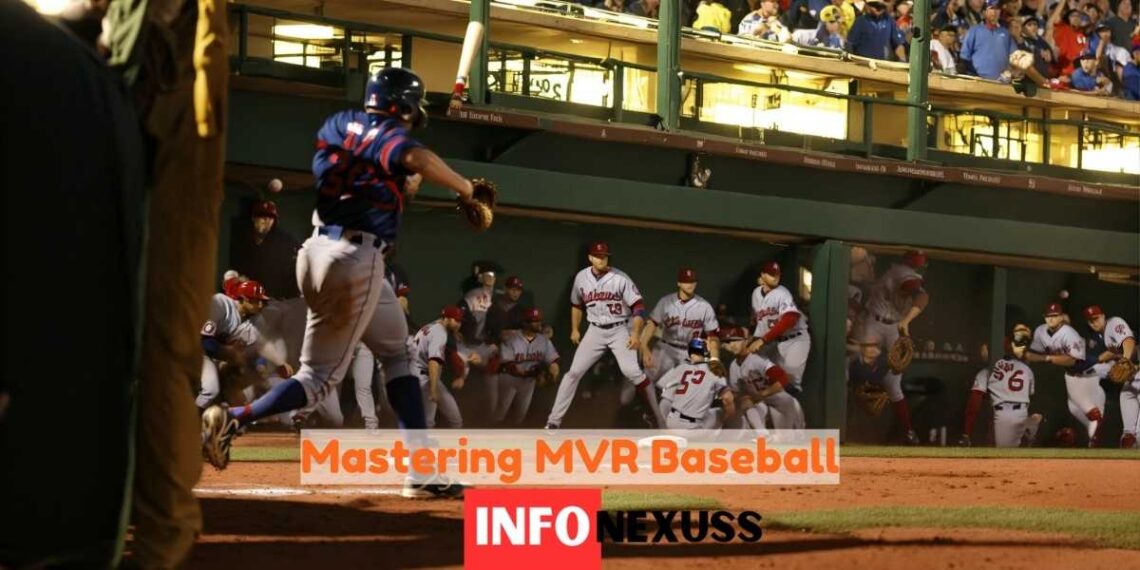
Mastering MVR Baseball: The Ultimate Data-Driven Guide
Decoding MVR: The Secret Weapon of Modern Baseball
Remember those agonizing mound visits that stretched baseball games into eternity? Well, in 2018, Major League Baseball (MLB) introduced a game-changer: the Mound Visits Remaining (MVR) rule. But MVR is more than just a way to speed up the game – it’s a window into a revolutionary statistical approach that’s reshaping how we understand America’s pastime.
MVR baseball isn’t about counting trips to the mound; it’s about unlocking a treasure trove of data-driven insights. By combining multiple variables – everything from batting average and on-base percentage to defensive metrics and ballpark factors – MVR paints a richer, more nuanced picture of player and team performance.
In this comprehensive guide, we’ll break down the complexities of MVR, making it accessible to both seasoned analysts and casual fans. You’ll discover how MVR Baseball is transforming player development, strategic decision-making, and even the way fans experience the game. Whether you’re a die-hard stats nerd or simply curious about the future of baseball, this is your ultimate guide to mastering MVR Baseball.
Table of Contents
- 1 What is MVR Baseball? Unraveling the Acronym and the Analysis
- 2 Why MVR Matters: The Data-Driven Revolution in Baseball
- 3 Key MVR Metrics Explained: The Numbers That Tell the Story
- 4 MVR in Action: Game-Changing Case Studies
- 5 Tools and Resources for MVR Enthusiasts: Your Gateway to Baseball’s Data Galaxy
- 6 The Future of MVR in Baseball: A Data-Driven Odyssey
- 7 The Bottom Line: MVR is More Than Just Numbers, It’s the Future of Baseball
What is MVR Baseball? Unraveling the Acronym and the Analysis
MVR, in the context of baseball, stands for Multi-Variate Response analysis. While the initialism might sound complex, the concept is surprisingly intuitive. In essence, MVR is a statistical approach that takes baseball analysis beyond the basics. Instead of looking at individual statistics in isolation (like batting average or ERA), MVR Baseball combines multiple variables to create a more holistic picture of player and team performance.
Think of it like this: Traditional baseball stats are like individual puzzle pieces. They offer some insights, but the full picture remains hidden. MVR is like assembling the puzzle, revealing the intricate connections between those pieces and painting a far more detailed and meaningful image.
How Does MVR Baseball Work?
MVR leverages sophisticated mathematical models to analyze a vast array of data points, including:
- Offensive Metrics: Batting average, on-base percentage, slugging percentage, home runs, stolen bases, etc.
- Defensive Metrics: Fielding percentage, range factor, defensive runs saved, etc.
- Pitching Metrics: Earned run average (ERA), strikeouts, walks, home runs allowed, etc.
- Contextual Factors: Ballpark dimensions, weather conditions, opponent strength, etc.
By crunching these numbers together, MVR Baseball generates advanced metrics that provide a deeper understanding of player value, team strengths and weaknesses, and the overall dynamics of the game.
A Brief History of MVR in Baseball
While MVR analysis has become increasingly popular in recent years, its roots can be traced back to the early days of sabermetrics, the field of baseball statistics that emerged in the 1970s. Bill James, the pioneer of sabermetrics, laid the groundwork for MVR Baseball by emphasizing the importance of looking beyond traditional stats.
In the 1980s and 1990s, analysts like Pete Palmer and Gary Gillette further developed MVR concepts, creating new metrics like OPS (On-Base Plus Slugging) and wRC+ (Weighted Runs Created Plus). These metrics, which combined multiple offensive stats, offered a more accurate assessment of a player’s offensive contributions.
Today, MVR has become mainstream in baseball. Teams employ dedicated analysts to crunch the numbers and gain a competitive edge. Fans utilize MVR Baseball data to enhance their understanding of the game and make informed decisions in fantasy leagues. Even broadcasters incorporate MVR insights into their commentary, enriching the viewer experience.
Key Advantages of MVR
- More Comprehensive Analysis: MVR goes beyond surface-level stats to provide a more holistic understanding of player and team performance.
- Improved Decision-Making: Coaches and managers use MVR Baseball data to make better decisions about lineups, pitching rotations, and in-game strategy.
- Enhanced Player Evaluation: MVR Baseball helps identify hidden talents and undervalued players, while also revealing areas where established stars can improve.
- Increased Fan Engagement: MVR provides fans with deeper insights into the game, making it more enjoyable and intellectually stimulating.
What to Expect in This Guide
In the following sections, we’ll delve deeper into the world of MVR Baseball. You’ll learn about the most essential MVR metrics, explore real-world case studies, discover useful tools and resources, and get a glimpse into the future of this game-changing approach to baseball analysis.
Why MVR Matters: The Data-Driven Revolution in Baseball
MVR Baseball isn’t just a fancy statistical tool; it’s a game-changer that’s revolutionizing how baseball is played, managed, and enjoyed. Here’s how MVR is making a difference for everyone involved in the sport:
1. Players: Gaining a Competitive Edge
For players, MVR Baseball is like having a personal performance coach in their pocket. By analyzing MVR data, players can:
- Identify Strengths and Weaknesses: MVR reveals hidden patterns in a player’s performance, highlighting areas where they excel and areas where they need improvement.
- Optimize Training: Armed with MVR Baseball insights, players can tailor their training regimens to address specific weaknesses and maximize their strengths.
- Improve Decision-Making on the Field: MVR helps players make smarter decisions in the heat of the moment, such as which pitch to swing at or when to attempt a stolen base.
Real-World Example: Houston Astros’ slugger, Jose Altuve, famously revamped his swing based on MVR Baseball data, significantly boosting his power numbers.
2. Coaches and Managers: Strategic Masterminds
For coaches and managers, MVR Baseball is a strategic weapon. It empowers them to:
- Evaluate Players More Accurately: MVR goes beyond traditional stats to assess a player’s true value, helping teams identify hidden gems and make informed roster decisions.
- Optimize Lineups and Rotations: MVR Baseball provides insights into how different players and pitchers perform in various situations, allowing managers to craft the most effective lineups and pitching rotations.
- Make Data-Driven In-Game Decisions: MVR data can inform tactical choices during games, such as when to bunt, steal, or intentionally walk a batter.
Real-World Example: The Tampa Bay Rays, known for their analytical approach, have consistently outperformed expectations thanks to their use of MVR Baseball data.
3. Fans: Deeper Understanding and Engagement
MVR Baseball isn’t just for the pros; it’s also enhancing the fan experience. By delving into MVR data, fans can:
- Gain a Deeper Understanding of the Game: MVR helps fans appreciate the nuances of baseball, understanding why certain players are more valuable than others and how specific in-game decisions are made.
- Make More Informed Fantasy Picks: MVR Baseball metrics like WAR and wOBA provide valuable insights for fantasy baseball players, helping them build winning teams.
- Engage in More Informed Discussions: MVR provides fans with a common language and a shared understanding of the game, leading to richer and more insightful conversations.
Real-World Example: The growing popularity of MVR Baseball has fueled the rise of fantasy sports websites and communities, where fans debate player values and strategies based on MVR data.
Key MVR Metrics Explained: The Numbers That Tell the Story
MVR isn’t just about complex formulas and data crunching; it’s about unlocking the stories hidden within the numbers. Here are some of the most important MVR metrics that help us understand baseball on a deeper level:
1. wOBA (Weighted On-Base Average): The Ultimate Offensive Measure
wOBA is like batting average on steroids. While batting average simply measures how often a batter gets a hit, wOBA takes into account the type of hit (single, double, triple, home run) and assigns different weights to each. This gives us a more accurate picture of a batter’s overall offensive contribution.
Think of it like this: A home run is obviously more valuable than a single. wOBA acknowledges this by giving more weight to home runs, making it a more comprehensive measure of offensive performance than batting average alone.
Why wOBA Matters:
- More Accurate Player Evaluation: wOBA helps identify truly elite hitters who may not have the highest batting averages but consistently produce runs.
- Better Lineup Decisions: Managers can use wOBA to construct lineups that maximize offensive potential.
- Fairer Comparisons: wOBA allows for meaningful comparisons between players who play in different ballparks or leagues.
2. WAR (Wins Above Replacement): The Gold Standard of Player Value
WAR is arguably the most important stat in modern baseball analysis. It measures a player’s overall value to their team, taking into account both offensive and defensive contributions.
Think of WAR as a player’s report card. A positive WAR indicates that the player is performing above average and contributing to their team’s wins. A negative WAR suggests the player is performing below average and potentially costing their team wins.
Why WAR Matters:
- Player Comparisons: WAR allows us to compare players across different positions and eras.
- Contract Negotiations: WAR is often used in contract negotiations to determine a player’s market value.
- Hall of Fame Debates: WAR has become a key factor in evaluating a player’s Hall of Fame credentials.
3. ERA+ (Adjusted ERA): The Pitcher’s Report Card, Contextualized
ERA (Earned Run Average) is the most common pitching statistic, but it can be misleading because it doesn’t account for factors like ballpark dimensions and league averages. ERA+ solves this problem by adjusting ERA based on these contextual factors.
Think of ERA+ as a pitcher’s ERA with a built-in handicap. A pitcher with a high ERA+ is performing well relative to their peers, even if their ERA isn’t particularly low.
Why ERA+ Matters:
- Fairer Comparisons: ERA+ allows us to compare pitchers who play in different ballparks and leagues.
- Better Understanding of Performance: ERA+ reveals whether a pitcher is truly elite or simply benefiting from favorable conditions.
- Improved Roster Decisions: Teams can use ERA+ to identify pitchers who are likely to succeed in their specific environment.
Other Relevant MVR Baseball Metrics
- DRS (Defensive Runs Saved): Quantifies a player’s defensive contribution by measuring how many runs they save compared to an average fielder at their position.
- FIP (Fielding Independent Pitching): Measures a pitcher’s effectiveness based on factors they can control (strikeouts, walks, home runs) rather than factors they can’t (defense).
- wRC+ (Weighted Runs Created Plus): Similar to wOBA, but adjusted for league and ballpark factors.
By understanding these key MVR metrics, you’ll be able to unlock a deeper level of baseball knowledge and appreciation.
MVR in Action: Game-Changing Case Studies
MVR isn’t just theoretical; it’s a practical tool that’s transforming the game. Here are three compelling case studies that illustrate the power of MVR Baseball:
Case Study 1: J.D. Martinez – The Swing Transformation
J.D. Martinez, now a prolific MLB slugger, was once a struggling hitter on the verge of being released. But in 2013, he embraced MVR Baseball analysis, using video and data to dissect his swing mechanics.
MVR Insights:
- Launch Angle: MVR data revealed that Martinez was hitting too many ground balls due to a low launch angle. By adjusting his swing to create a higher launch angle, he could increase the frequency of line drives and fly balls, resulting in more extra-base hits and home runs.
- Bat Path: MVR analysis also showed that Martinez’s bat path was inefficient, causing him to miss hittable pitches. By optimizing his bat path, he could make more consistent contact and drive the ball with greater authority.
Results:
Martinez’s transformation was nothing short of remarkable. His home run production skyrocketed, and he became one of the most feared hitters in baseball. MVR Baseball didn’t just save his career; it turned him into a superstar.
Case Study 2: The Oakland A’s – Moneyball 2.0
The Oakland Athletics, famous for their “Moneyball” approach in the early 2000s, have continued to be at the forefront of MVR Baseball analysis. With limited financial resources, the A’s rely on MVR to identify undervalued players who possess hidden potential.
MVR Insights:
- Underrated Defenders: MVR metrics like Defensive Runs Saved (DRS) helped the A’s unearth defensive gems who were overlooked by other teams.
- Plate Discipline: By analyzing on-base percentage (OBP) and walk rates, the A’s identified batters with exceptional plate discipline, even if their batting averages weren’t eye-popping.
- Pitching Arsenal: MVR insights into pitch types, velocity, and movement helped the A’s build a pitching staff that consistently outperformed expectations.
Results:
The A’s have consistently contended for playoff spots despite having one of the lowest payrolls in baseball. Their success is a testament to the power of MVR Baseball in identifying hidden value and building a competitive team on a budget.
Case Study 3: The 2017 World Series – MVR Baseball Informs Game-Changing Decisions
In the pivotal Game 2 of the 2017 World Series, the Houston Astros faced a dilemma. Their ace pitcher, Justin Verlander, was struggling in the 6th inning. The traditional decision would have been to stick with Verlander, but MVR Baseball data suggested a different course of action.
MVR Insights:
- Matchup Data: MVR analysis revealed that the Dodgers’ hitters had a favorable track record against Verlander’s fastball.
- Bullpen Strengths: The Astros’ bullpen, meanwhile, featured pitchers with diverse arsenals who were better equipped to neutralize the Dodgers’ lineup.
Results:
Astros manager A.J. Hinch made the bold decision to pull Verlander and rely on his bullpen. The move paid off as the Astros rallied to win the game and eventually the World Series. This pivotal moment showcased how MVR Baseball can inform crucial in-game decisions and even alter the course of history.
Tools and Resources for MVR Enthusiasts: Your Gateway to Baseball’s Data Galaxy
Eager to dive deeper into the world of MVR Baseball? Thankfully, there’s a wealth of resources available to both casual fans and seasoned analysts. Here’s a curated list of websites, software, and apps that offer MVR baseball data and analysis:
1. Fangraphs: The Gold Standard
Pros:
- Comprehensive Data: Boasts a vast library of MVR stats, including WAR, wOBA, FIP, and more, dating back decades.
- Advanced Features: Offers customizable leaderboards, player comparisons, and in-depth articles on advanced metrics.
- Community: Thriving community of analysts and fans for discussions and insights.
Cons:
- Steep Learning Curve: Some features and data visualizations can be overwhelming for beginners.
- Free Version Limitations: Certain premium features require a subscription.
Best for: Serious analysts and fantasy baseball enthusiasts seeking in-depth data and analysis.
2. Baseball Savant: MLB’s Official Statcast Hub
Pros:
- Statcast Data: Provides access to MLB’s Statcast data, including Statcast-based MVR Baseball metrics like Expected Batting Average (xBA) and Expected Weighted On-Base Average (xwOBA).
- Visually Appealing: Features interactive visualizations and tools for exploring MVR data.
- Beginner-Friendly: Offers an intuitive interface that’s easy to navigate.
Cons:
- Limited Historical Data: Statcast data only goes back to 2015.
- Less Comprehensive: Doesn’t offer the same depth of analysis as Fangraphs.
Best for: Casual fans and those interested in exploring the visual aspects of MVR Baseball data.
3. Baseball Reference: The Encyclopedia of Baseball
Pros:
- Vast Historical Database: Contains an unparalleled collection of baseball data dating back to the 19th century.
- User-Friendly: Offers a simple, straightforward interface.
- Free: All features are accessible without a subscription.
Cons:
- Limited Advanced Metrics: Focuses more on traditional stats, although it does offer some basic MVR Baseball metrics.
- Less Interactive: Doesn’t have the same visual appeal as Baseball Savant.
Best for: Fans interested in historical research and those seeking a more traditional approach to baseball stats.
4. Baseball Prospectus: The Think Tank of Baseball Analysis
Pros:
- Cutting-Edge Analysis: Publishes insightful articles and research on advanced MVR metrics and concepts.
- Innovative Metrics: Introduces new MVR metrics and models, pushing the boundaries of baseball analysis.
- Community: Fosters a community of passionate baseball analysts and fans.
Cons:
- Paywall: Many articles and features require a subscription.
- Technical: Some content can be challenging for beginners.
Best for: Serious analysts and those seeking the latest insights and research on MVR Baseball.
5. The Athletic: In-Depth Reporting and Analysis
Pros:
- High-Quality Journalism: Features in-depth articles on MVR and its impact on the game.
- Expert Opinions: Employs seasoned baseball writers and analysts.
- Engaging Storytelling: Combines data with captivating narratives to make MVR accessible and interesting.
Cons:
- Subscription Required: All content is behind a paywall.
- Not Exclusively MVR Baseball: Covers a wide range of baseball topics, so you’ll need to search for MVR-specific content.
Best for: Fans who enjoy long-form journalism and want to understand the broader context of MVR in baseball.
Choosing the Right Tool
The best tool for you depends on your needs and interests. If you’re a casual fan, Baseball Savant or Baseball Reference might be a good starting point. If you’re a serious analyst, Fangraphs or Baseball Prospectus offer the depth and features you’ll need. And if you enjoy reading in-depth articles, The Athletic is a great option.
Also Read: BOLTBÓL: ICELAND’S ANCIENT SPORT FOR THE MODERN WORLD
The Future of MVR in Baseball: A Data-Driven Odyssey
MVR is already a transformative force in baseball, but its evolution is far from over. As technology advances and data becomes even more integral to the sport, MVR Baseball is poised to unlock new levels of insight and revolutionize various aspects of the game.
1. Machine Learning and AI: The Dynamic Duo of MVR Analysis
Machine learning (ML) and artificial intelligence (AI) are rapidly becoming indispensable tools in MVR analysis. These technologies can sift through massive amounts of data, identify complex patterns, and generate predictions with remarkable accuracy.
- Predictive Modeling: ML algorithms can forecast player performance, injury risk, and even the outcome of games with increasing precision.
- Personalized Training: AI-powered systems can analyze a player’s unique strengths and weaknesses, tailoring training programs to maximize their potential.
- Real-Time Insights: ML models can process data in real-time, providing coaches and managers with instant feedback to inform in-game decisions.
The marriage of MVR Baseball and AI is already bearing fruit. For instance, some MLB teams are using ML to predict the optimal pitch sequence for each batter, giving their pitchers a significant advantage.
2. Revolutionizing Scouting and Player Development
MVR Baseball is reshaping how teams identify and develop talent. In the past, scouting relied heavily on subjective evaluations and limited data points. Now, MVR provides scouts with a wealth of objective data to inform their decisions.
- Uncovering Hidden Talent: MVR Baseball can unearth players with untapped potential who might have been overlooked by traditional scouting methods.
- Data-Driven Player Development: MVR data can be used to create personalized development plans for each player, targeting specific areas for improvement.
- Predicting Future Performance: ML algorithms can project how a player’s skills might develop over time, helping teams make smarter draft and trade decisions.
This data-driven approach to scouting and development is leveling the playing field, giving smaller-market teams a chance to compete with big spenders.
3. Ethical Considerations: Striking a Balance
While the potential of MVR Baseball is immense, it’s important to consider the ethical implications. As we collect and analyze more data, issues like privacy, bias, and fairness come to the forefront.
- Privacy Concerns: MVR relies on collecting vast amounts of personal data on players. It’s crucial to ensure that this data is handled responsibly and that players have control over their own information.
- Bias in Algorithms: ML algorithms are only as good as the data they’re trained on. If that data is biased, the algorithms will be too, potentially leading to unfair or discriminatory outcomes.
- Fairness and Access: MVR insights can give teams a significant advantage. It’s important to consider how to ensure that all teams have access to this technology to maintain a competitive balance.
As we navigate the future of MVR Baseball, it’s essential to strike a balance between innovation and ethical responsibility. By doing so, we can harness the power of MVR to enhance the game of baseball while upholding the values of fairness and equity.
The Bottom Line: MVR is More Than Just Numbers, It’s the Future of Baseball
In this exploration of MVR Baseball, we’ve unearthed a statistical revolution that’s reshaping how we understand and engage with America’s pastime. From its origins in the early days of sabermetrics to its integration with cutting-edge technologies like AI, MVR has proven its transformative power.
Key Takeaways:
- MVR is About Context: It goes beyond basic stats, considering multiple variables to provide a deeper understanding of player and team performance.
- MVR Empowers Everyone: Players use it to refine their game, coaches to make strategic decisions, and fans to deepen their appreciation of the sport.
- MVR is a Game-Changer: From identifying hidden talent to informing in-game strategy, MVR is revolutionizing how baseball is played and analyzed.
- MVR is the Future: As technology advances, MVR Baseball will continue to evolve, offering even more powerful insights and shaping the future of baseball.
Embrace the Data-Driven Revolution
If you’re a baseball fan, player, or coach, I encourage you to dive into the world of MVR. Explore the resources mentioned in this guide, experiment with different tools, and join the vibrant online communities dedicated to MVR Baseball analysis.
By embracing MVR, you’ll not only gain a deeper understanding of the game but also unlock a new level of enjoyment and engagement. Whether you’re using MVR Baseball to build a fantasy team, debate player values, or simply appreciate the finer points of a game, this knowledge will enrich your baseball experience.
Join the Conversation
Have you used MVR Baseball data to gain new insights into baseball? Share your experiences and thoughts in the comments below. Let’s continue the conversation and explore the exciting possibilities that MVR holds for the future of our beloved sport.
You May Also Like

GarnetHillsKids.Com: Kids’ Fashion Guide
June 5, 2024
Is www.filmesgratiscinefilmeshd.com.br Safe & Legal?
December 5, 2024

